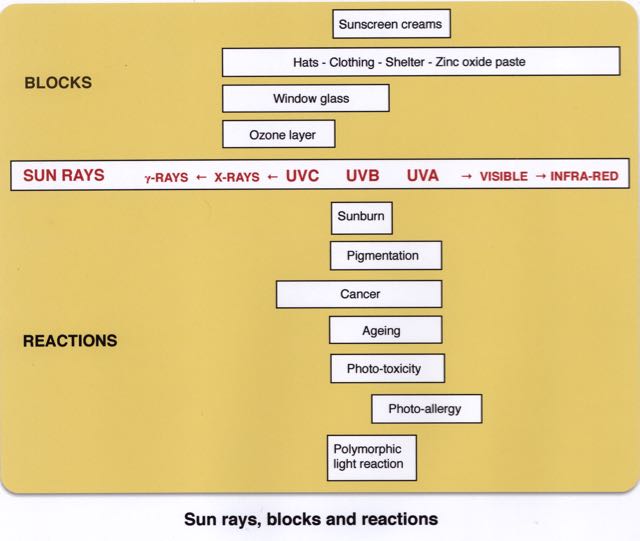Sun blocks, sun-skin reactions, and atopic eczema
 |
Sun rays
The sun rays that cause skin reactions are mostly invisible and in the ultra violet wavelength range: UVA [400nm - 320nm], and UVB [320-290nm]. Fortunately UVC [290-200nm] is filtered out by the ozone layer. However visible light can cause allergic reactions - see below.
Sun blocks
- Most sunscreen creams protect from both UVA and UVB, not visible light, but there are reflectant sunscreens that offer protection from visible light too.
- The best protection is staying out of the sun, and if in the sun, wearing a hat and appropriate clothes.
- Window glass blocks UVB.
Sun-skin reactions
Caused by excessive UVB exposure, begins with tingling and redness after several hours, can become painful with blistering. Maximal after one day, then settles over two or more days.
Long-term effects: wrinkling, pigmentation changes, and cancer.
Treatment: moisturiser; oily calamine lotion. Early and briefly: a potent [Grade II] topical steroid e.g. Elocon (mometasone furoate 0.1%) once daily. Aspirin by mouth.
- Pigmentation, cancer and skin ageing
Suntan is produced by both UVA and UVB exposure. The long-term risks include skin cancer, and premature skin ageing effects:
“ The bronzed young folk of today will be the wrinkled prunes of tomorrow”
Appears just like sunburn - see above - but caused by both UVA and UVB exposure, combined with the use of a skin sensitising chemical, or medication - including some antidepressants, tranquillisers, diuretics, oral contraceptives and antibiotics.
Only the skin exposed to the sun is affected.
It is not allergy - it affects anyone taking enough of the medication, with enough ultraviolet ray exposure; however, some of these drugs also cause photo-allergy reactions - see below - and this includes some sunscreen creams!
Plant substances sometimes cause photo-toxic reactions: phytophotodermatitis.
Less common than photo-toxic reactions, photo-allergic reactions are caused by exposure mostly by UVA and visible sunlight exposure, combined with medication use - sometimes by mouth, but more often applied to the skin - or with certain chemicals being on the skin. An antigen is formed in the skin and causes the reaction. Unlike sunburn and photo-toxic reactions, a photo-allergic reaction is delayed, and occurs only after a second or further exposure to sunshine. The skin reaction is less like a burn and more like acute eczema, and may extend to areas not exposed to the sun.
Treatment involves stopping the medication, protection from sun exposure and use of anti-inflammatory medication.
This is the most common form of “sun allergy”. It is similar to drug photo-allergy but more often caused by UVB exposure, and may involve a naturally chemical in the skin becoming an allergen. The reaction tends to affect skin that is exposed in the summer but covered in the winter. Sun tan sometimes protects: as the summer progresses, it can become less of a problem and it commonly disappears in the winter.
It may be more common in young females with fair skin living in the less sunny parts of the world.
Atopic eczema and sun-skin reactions
- Generally atopic eczema improves in the sun. Ultraviolet phototherapy is used as a treatment.
- Unusually atopic eczema is worsened by the sun. This is photo-aggravated or photosensitive atopic eczema, with onset or exacerbation following sunlight or UV exposure.
- Polymorphic light eruption - see above - can occur together with atopic eczema.
See also:
